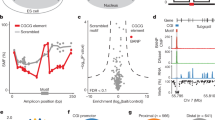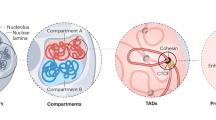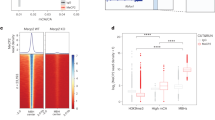Abstract
CpG islands (CGIs) are prominent in the mammalian genome owing to their GC-rich base composition and high density of CpG dinucleotides1,2. Most human gene promoters are embedded within CGIs that lack DNA methylation and coincide with sites of histone H3 lysine 4 trimethylation (H3K4me3), irrespective of transcriptional activity3,4. In spite of these intriguing correlations, the functional significance of non-methylated CGI sequences with respect to chromatin structure and transcription is unknown. By performing a search for proteins that are common to all CGIs, here we show high enrichment for Cfp1, which selectively binds to non-methylated CpGs in vitro5,6. Chromatin immunoprecipitation of a mono-allelically methylated CGI confirmed that Cfp1 specifically associates with non-methylated CpG sites in vivo. High throughput sequencing of Cfp1-bound chromatin identified a notable concordance with non-methylated CGIs and sites of H3K4me3 in the mouse brain. Levels of H3K4me3 at CGIs were markedly reduced in Cfp1-depleted cells, consistent with the finding that Cfp1 associates with the H3K4 methyltransferase Setd1 (refs 7, 8). To test whether non-methylated CpG-dense sequences are sufficient to establish domains of H3K4me3, we analysed artificial CpG clusters that were integrated into the mouse genome. Despite the absence of promoters, the insertions recruited Cfp1 and created new peaks of H3K4me3. The data indicate that a primary function of non-methylated CGIs is to genetically influence the local chromatin modification state by interaction with Cfp1 and perhaps other CpG-binding proteins.
This is a preview of subscription content, access via your institution
Access options
Subscribe to this journal
Receive 51 print issues and online access
$199.00 per year
only $3.90 per issue
Buy this article
- Purchase on SpringerLink
- Instant access to full article PDF
Prices may be subject to local taxes which are calculated during checkout




Similar content being viewed by others
References
Bird, A. P. CpG-rich islands and the function of DNA methylation. Nature 321, 209–213 (1986)
Suzuki, M. M. & Bird, A. DNA methylation landscapes: provocative insights from epigenomics. Nature Rev. Genet. 9, 465–476 (2008)
Guenther, M. G., Levine, S. S., Boyer, L. A., Jaenisch, R. & Young, R. A. A chromatin landmark and transcription initiation at most promoters in human cells. Cell 130, 77–88 (2007)
Bernstein, B. E. et al. A bivalent chromatin structure marks key developmental genes in embryonic stem cells. Cell 125, 315–326 (2006)
Lee, J. H. & Skalnik, D. G. CpG-binding protein is a nuclear matrix- and euchromatin-associated protein localized to nuclear speckles containing human trithorax. Identification of nuclear matrix targeting signals. J. Biol. Chem. 277, 42259–42267 (2002)
Shin Voo, K., Carlone, D. L., Jacobsen, B. M., Flodin, A. & Skalnik, D. G. Cloning of a mammalian transcriptional activator that binds unmethylated CpG motifs and shares a CXXC domain with DNA methyltransferase, human trithorax, and methyl-CpG binding domain protein 1. Mol. Cell. Biol. 20, 2108–2121 (2000)
Lee, J. H. & Skalnik, D. G. CpG-binding protein (CXXC finger protein 1) is a component of the mammalian Set1 histone H3-Lys4 methyltransferase complex, the analogue of the yeast Set1/COMPASS complex. J. Biol. Chem. 280, 41725–41731 (2005)
Lee, J. H., Tate, C. M., You, J. S. & Skalnik, D. G. Identification and characterization of the human Set1B histone H3-Lys4 methyltransferase complex. J. Biol. Chem. 282, 13419–13428 (2007)
Tazi, J. & Bird, A. Alternative chromatin structure at CpG islands. Cell 60, 909–920 (1990)
Mikkelsen, T. S. et al. Genome-wide maps of chromatin state in pluripotent and lineage-committed cells. Nature 448, 553–560 (2007)
Barski, A. et al. High-resolution profiling of histone methylations in the human genome. Cell 129, 823–837 (2007)
Lee, J. H., Voo, K. S. & Skalnik, D. G. Identification and characterization of the DNA binding domain of CpG-binding protein. J. Biol. Chem. 276, 44669–44676 (2001)
Tsukada, Y. et al. Histone demethylation by a family of JmjC domain-containing proteins. Nature 439, 811–816 (2006)
McDonald, L. E., Paterson, C. A. & Kay, G. F. Bisulfite genomic sequencing-derived methylation profile of the Xist gene throughout early mouse development. Genomics 54, 379–386 (1998)
Lewis, J. D. et al. Purification, sequence and cellular localisation of a novel chromosomal protein that binds to methylated DNA. Cell 69, 905–914 (1992)
Nan, X., Tate, P., Li, E. & Bird, A. DNA methylation specifies chromosomal localization of MeCP2. Mol. Cell. Biol. 16, 414–421 (1996)
Skene, P. J. et al. Neuronal MeCP2 is expressed at near histone-octamer levels and globally alters the chromatin state. Mol. Cell 37, 457–468 (2010)
Mikkelsen, T. S. et al. Dissecting direct reprogramming through integrative genomic analysis. Nature 454, 49–55 (2008)
Schwartz, Y. B. & Pirrotta, V. Polycomb complexes and epigenetic states. Curr. Opin. Cell Biol. 20, 266–273 (2008)
Chambers, I. et al. Nanog safeguards pluripotency and mediates germline development. Nature 450, 1230–1234 (2007)
Yang, T. T., Cheng, L. & Kain, S. R. Optimized codon usage and chromophore mutations provide enhanced sensitivity with the green fluorescent protein. Nucleic Acids Res. 24, 4592–4593 (1996)
Guy, J., Gan, J., Selfridge, J., Cobb, S. & Bird, A. Reversal of neurological defects in a mouse model of Rett syndrome. Science 315, 1143–1147 (2007)
Waterston, R. H. et al. Initial sequencing and comparative analysis of the mouse genome. Nature 420, 520–562 (2002)
Ooi, S. K. et al. DNMT3L connects unmethylated lysine 4 of histone H3 to de novo methylation of DNA. Nature 448, 714–717 (2007)
Brandeis, M. et al. Sp1 elements protect a CpG island from de novo methylation. Nature 371, 435–438 (1994)
Macleod, D., Charlton, J., Mullins, J. & Bird, A. P. Sp1 sites in the mouse aprt gene promoter are required to prevent methylation of the CpG island. Genes Dev. 8, 2282–2292 (1994)
Lorincz, M. C., Dickerson, D. R., Schmitt, M. & Groudine, M. Intragenic DNA methylation alters chromatin structure and elongation efficiency in mammalian cells. Nature Struct. Mol. Biol. 11, 1068–1075 (2004)
Lorincz, M. C., Schubeler, D. & Groudine, M. Methylation-mediated proviral silencing is associated with MeCP2 recruitment and localized histone H3 deacetylation. Mol. Cell. Biol. 21, 7913–7922 (2001)
Illingworth, R. et al. A novel CpG island set identifies tissue-specific methylation at developmental gene loci. PLoS Biol. 6, e22 (2008)
Meissner, A. et al. Genome-scale DNA methylation maps of pluripotent and differentiated cells. Nature 454, 766–770 (2008)
Klose, R. J. & Bird, A. P. MeCP2 behaves as an elongated monomer that does not stably associate with the Sin3a chromatin remodeling complex. J. Biol. Chem. 279, 46490–46496 (2004)
Schmiedeberg, L., Skene, P., Deaton, A. & Bird, A. A temporal threshold for formaldehyde crosslinking and fixation. PLoS ONE 4, e4636 (2009)
Araki, K., Araki, M. & Yamamura, K. Targeted integration of DNA using mutant lox sites in embryonic stem cells. Nucleic Acids Res. 25, 868–872 (1997)
Acknowledgements
We are grateful to D. Skalnik for the gift of a Cfp1 antibody, I. Chambers for the TβC44 ES cell line, R. Klose for discussions, E. Sheridan for testing the DNA sequencing protocol, and K. Auger and J. Parkhill for coordinating the DNA sequencing. We also thank R. Ekiert and J. Connelly for comments on the manuscript. This work was funded by a Cancer Research UK studentship to J.P.T. and by grants from the Wellcome Trust, the Medical Research Council and the European Union ‘Epigenome’ Network of Excellence.
Author Contributions J.P.T. and P.J.S. performed the ChIP, knockdown and bisulphite analysis. T.C. did preliminary ChIP analysis. J.S. and J.G. generated the MeCP2-eGFP cell line. J.S. performed bisulphite analysis of the TβC44 ES cell line. R.I. prepared samples for sequencing. K.D.J., D.J.T. and R.A. performed the sequencing and mapping. S.W., A.R.W.K., A.D. and R.I. performed the bioinformatic analysis. J.P.T., P.J.S., T.C., R.I. and A.B. wrote the manuscript.
Author information
Authors and Affiliations
Corresponding author
Supplementary information
Supplementary Information
This file contains Supplementary Figures S1 - S4 with legends and reference for Supplementary Figure S2, legend for Supplementary Table S1 (see separate Supplementary Table file) and Supplementary Tables S2 - S3. (PDF 558 kb)
Supplementary Table 1
This table shows the association of Cfp1, histone H3K4me3, H3K27me3 and RNA polymerase II with non-methylated CGIs. (see Supplementary Information file for full legend). (XLS 1090 kb)
Rights and permissions
About this article
Cite this article
Thomson, J., Skene, P., Selfridge, J. et al. CpG islands influence chromatin structure via the CpG-binding protein Cfp1. Nature 464, 1082–1086 (2010). https://doi.org/10.1038/nature08924
Received:
Accepted:
Issue Date:
DOI: https://doi.org/10.1038/nature08924
This article is cited by
-
CpG island turnover events predict evolutionary changes in enhancer activity
Genome Biology (2024)
-
CXXC finger protein 1 (CFP1) bridges the reshaping of genomic H3K4me3 signature to the advancement of lung adenocarcinoma
Signal Transduction and Targeted Therapy (2023)
-
A genome-wide screen reveals new regulators of the 2-cell-like cell state
Nature Structural & Molecular Biology (2023)
-
Alternative promoters in CpG depleted regions are prevalently associated with epigenetic misregulation of liver cancer transcriptomes
Nature Communications (2023)
-
CFP1 governs uterine epigenetic landscapes to intervene in progesterone responses for uterine physiology and suppression of endometriosis
Nature Communications (2023)



